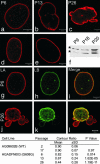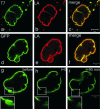Accumulation of mutant lamin A causes progressive changes in nuclear architecture in Hutchinson-Gilford progeria syndrome
- PMID: 15184648
- PMCID: PMC428455
- DOI: 10.1073/pnas.0402943101
Accumulation of mutant lamin A causes progressive changes in nuclear architecture in Hutchinson-Gilford progeria syndrome
Abstract
Hutchinson-Gilford progeria syndrome (HGPS) is a premature aging disorder, commonly caused by a point mutation in the lamin A gene that results in a protein lacking 50 aa near the C terminus, denoted LADelta50. Here we show by light and electron microscopy that HGPS is associated with significant changes in nuclear shape, including lobulation of the nuclear envelope, thickening of the nuclear lamina, loss of peripheral heterochromatin, and clustering of nuclear pores. These structural defects worsen as HGPS cells age in culture, and their severity correlates with an apparent increase in LADelta50. Introduction of LADelta50 into normal cells by transfection or protein injection induces the same changes. We hypothesize that these alterations in nuclear structure are due to a concentration-dependent dominant-negative effect of LADelta50, leading to the disruption of lamin-related functions ranging from the maintenance of nuclear shape to regulation of gene expression and DNA replication.
Figures





Similar articles
-
Hutchinson-Gilford progeria mutant lamin A primarily targets human vascular cells as detected by an anti-Lamin A G608G antibody.Proc Natl Acad Sci U S A. 2006 Feb 14;103(7):2154-9. doi: 10.1073/pnas.0511133103. Epub 2006 Feb 6. Proc Natl Acad Sci U S A. 2006. PMID: 16461887 Free PMC article.
-
A lamin A protein isoform overexpressed in Hutchinson-Gilford progeria syndrome interferes with mitosis in progeria and normal cells.Proc Natl Acad Sci U S A. 2007 Mar 20;104(12):4949-54. doi: 10.1073/pnas.0611640104. Epub 2007 Mar 14. Proc Natl Acad Sci U S A. 2007. PMID: 17360355 Free PMC article.
-
Reversal of the cellular phenotype in the premature aging disease Hutchinson-Gilford progeria syndrome.Nat Med. 2005 Apr;11(4):440-5. doi: 10.1038/nm1204. Epub 2005 Mar 6. Nat Med. 2005. PMID: 15750600 Free PMC article.
-
Hutchinson-Gilford progeria syndrome through the lens of transcription.Aging Cell. 2013 Aug;12(4):533-43. doi: 10.1111/acel.12070. Epub 2013 Apr 19. Aging Cell. 2013. PMID: 23496208 Review.
-
Epigenetic involvement in Hutchinson-Gilford progeria syndrome: a mini-review.Gerontology. 2014;60(3):197-203. doi: 10.1159/000357206. Epub 2014 Feb 28. Gerontology. 2014. PMID: 24603298 Review.
Cited by
-
Jumping over the fence: RNA nuclear export revisited.Nucleus. 2013 Mar-Apr;4(2):95-9. doi: 10.4161/nucl.24237. Epub 2013 Mar 1. Nucleus. 2013. PMID: 23528257 Free PMC article.
-
Mesenchymal stem cells derived from patients with premature aging syndromes display hallmarks of physiological aging.Life Sci Alliance. 2022 Sep 14;5(12):e202201501. doi: 10.26508/lsa.202201501. Life Sci Alliance. 2022. PMID: 36104080 Free PMC article.
-
Naïve adult stem cells from patients with Hutchinson-Gilford progeria syndrome express low levels of progerin in vivo.Biol Open. 2012 Jun 15;1(6):516-26. doi: 10.1242/bio.20121149. Epub 2012 Apr 16. Biol Open. 2012. PMID: 23213444 Free PMC article.
-
Barrier-to-Autointegration Factor influences specific histone modifications.Nucleus. 2011 Nov-Dec;2(6):580-90. doi: 10.4161/nucl.2.6.17960. Epub 2011 Nov 1. Nucleus. 2011. PMID: 22127260 Free PMC article.
-
The NLRP3 inhibitor Dapansutrile improves the therapeutic action of lonafarnib on progeroid mice.Aging Cell. 2024 Sep;23(9):e14272. doi: 10.1111/acel.14272. Epub 2024 Aug 27. Aging Cell. 2024. PMID: 39192596 Free PMC article.
References
Publication types
MeSH terms
Substances
LinkOut - more resources
Full Text Sources
Other Literature Sources
Medical
Research Materials

